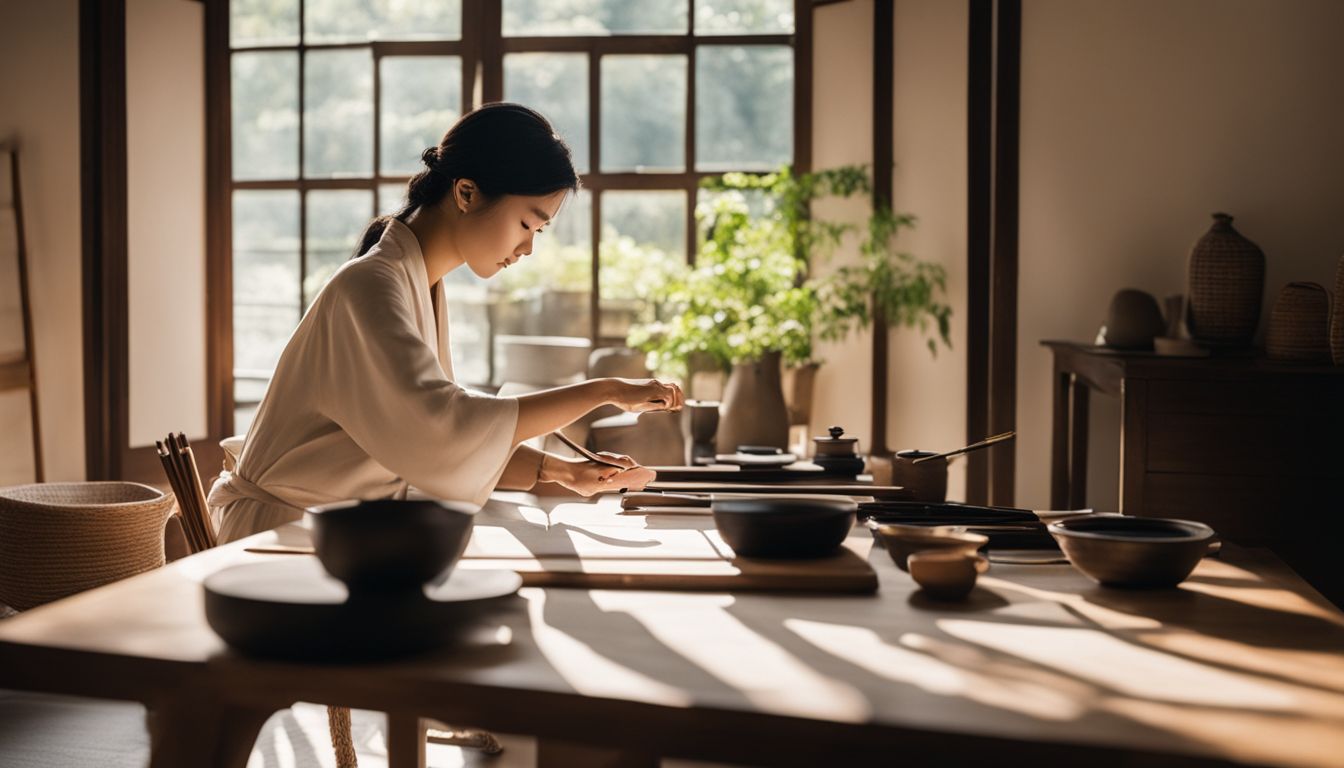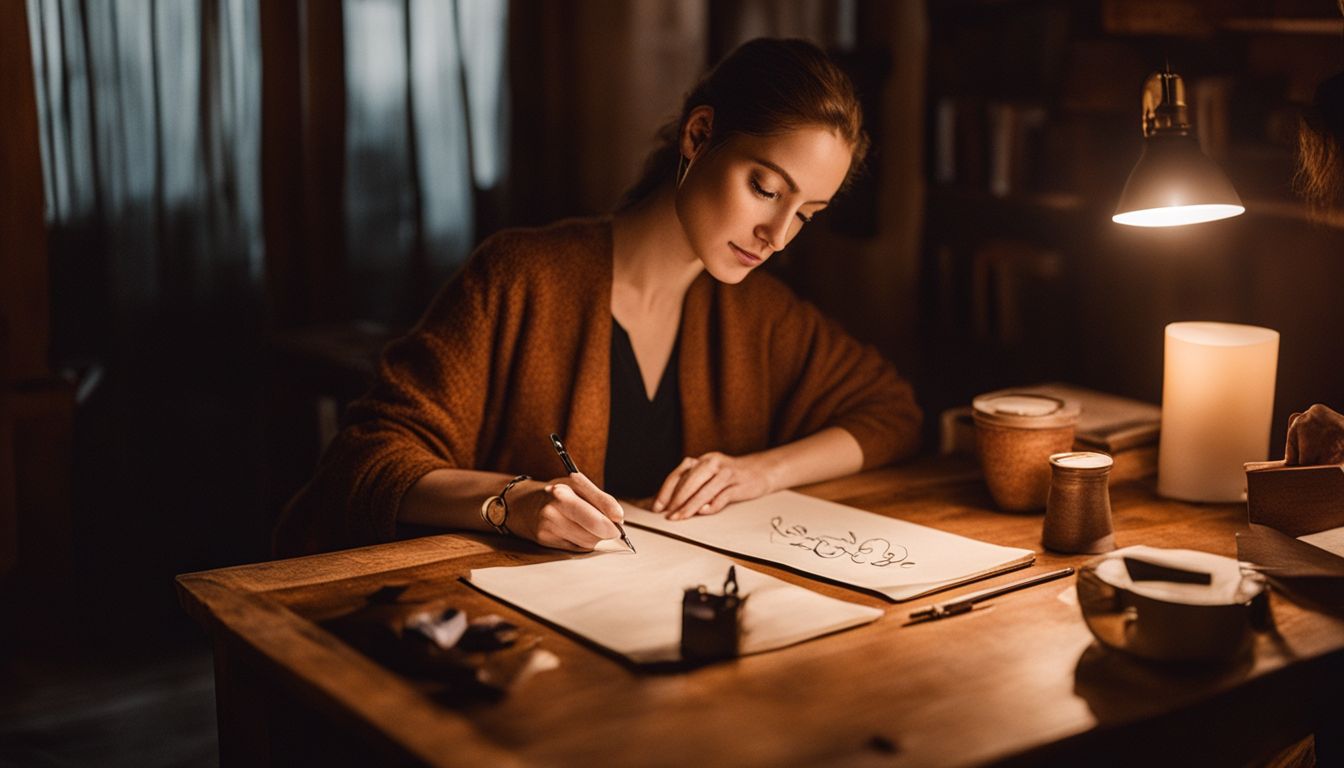Finding the right words to say “congratulations” can be hard. Elegant congratulations calligraphy turns those words into a beautiful art form. Our article shows you how to use pens, ink, and paper to make your congratulatory messages stand out.
Keep reading for tips that will impress.
Essential Tools for Congratulations Calligraphy

Select the right pen and ink for your calligraphy work. Choose quality paper to enhance your hand-lettered greetings.
Choosing the Right Pen and Ink
Choosing the right tools is crucial for anyone getting into modern calligraphy, especially for special occasions like arabic or islamic weddings, engagements, and even merry christmas greetings.
For beginners and professionals alike, finding a pen that feels comfortable in your hand makes a big difference. Fountain pens, brush pens, and dip pens are popular choices due to their range of nib sizes and flexibility.
This variety allows for broad strokes down to fine lines in your handlettering projects.
For those vibrant wedding invitations or elegant engagement announcements, selecting waterproof and archival-quality ink ensures that your work lasts without fading or smudging over time.
With inks available in various colors, including special editions like sakura-themed shades for that personal touch, you can truly tailor your artwork to the occasion. Price ranges vary greatly from budget-friendly options suitable for practice to high-end products offering professional results with free shipping deals often available online.
Selecting Quality Paper
Finding the best paper for your congratulations calligraphy, especially if it’s for an Arabic wedding card, becomes crucial for achieving that elegant finish. Papers vary widely in texture and weight.
Go for sheets that are either smooth or have a slight texture to make your ink flow beautifully without bleeding. Considering the paper weight is also essential; aim for something between 70-120 gsm (grams per square meter).
This range provides enough heft to support ink well without being too thick.
In my experience, certain brands stand out when looking for quality calligraphy paper. While premium papers can cost a bit more, investing in them ensures your artwork stands out. Whether using PSD templates as a guide or drawing freehand, the right paper makes all the difference.
Every stroke of ink sits perfectly on high-quality paper, giving each letter and swirl a crisp appearance which is vital in making those greetings look exceptional.
Core Techniques for Elegant Lettering
Mastering elegant lettering involves understanding basic strokes and mastering script styles. Refining these essential techniques will elevate the quality of your calligraphy work.
Understanding Basic Strokes
Basic strokes form the foundation of elegant lettering in calligraphy. These simple lines and curves connect to create letters and words. Practicing these basic movements with consistency is key.
You should apply uniform pressure while drawing each stroke to ensure smooth, balanced letters. This skill lays the groundwork for more complex letter forms and styles.
Experts recommend practicing calligraphy for 15-30 minutes daily to improve your technique gradually. Uniformity in your strokes leads to better results over time, making practice a crucial part of mastering calligraphy.
Next, we’ll delve into mastering script styles, where you will learn how to bring individuality and flair to your writing by building on these basic skills.
Mastering Script Styles
After understanding basic strokes, mastering script styles is the next step in becoming proficient in celebratory calligraphy. Different scripts such as Copperplate, Spencerian, and Italic offer various levels of formality and artistic expression.
Each script style has its own unique use for conveying different emotions and messages in hand-lettered greetings. Workshops and online courses designed to enhance mastery of these diverse script styles are available for those desiring a deeper understanding of celebratory calligraphy.
Exploring Variations in Calligraphy Lines
To achieve diverse effects in calligraphy, it’s essential to vary line thickness and texture. Line variation adds visual interest and dimension to hand-lettered greetings. Experiment with different nibs, adjusting pressure and angles to create distinct variations in your calligraphy lines.
This technique enables the creation of refined scripts customized for the particular style desired.
Conclusion
Mastering celebratory calligraphy entails grasping fundamental strokes and choosing high-quality tools such as pens and ink. Creating graceful hand-lettered greetings demands patience, dedication, and a discerning eye for detail.
Adding the recipient’s name and relevant symbols personalizes messages and brings a distinctive flair to your designs. Embracing calligraphy not only improves communication skills but also unleashes creativity in conveying sincere sentiments.
Perfecting these techniques can empower you to produce exquisite and significant celebratory messages for diverse occasions.
For more in-depth exploration on how to enhance your calligraphy with unique line variations, visit our detailed guide here.
FAQs
1. What is congratulations calligraphy and how can I master it?
Congratulations calligraphy is the art of hand-lettering greetings to express joy on someone’s achievement. Mastering this art involves learning specific techniques, practicing regularly, and using the right tools.
2. Can anyone learn to write elegant hand-lettered greetings?
Yes! With patience, practice, and proper guidance, anyone can learn to create beautiful hand-lettered congratulations messages.
3. Are there any tips for improving my congratulations calligraphy skills?
Sure! Regular practice with different letter styles, maintaining a steady hand pressure while writing and experimenting with various ink types can greatly enhance your calligraphy skills.
4. How do I make my congratulatory message stand out in calligraphy?
To make your congratulatory message stand out in calligraphy, you should focus on creating unique letter shapes, incorporating decorative elements like flourishes or borders into your work, and choosing vibrant ink colors that convey emotion.




Leave a Reply
You must be logged in to post a comment.